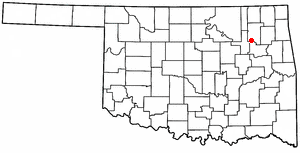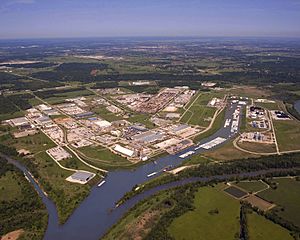Tulsa Ports facts for kids
The Tulsa Ports are important shipping centers in Oklahoma, United States. They include the ports of Catoosa and Inola. These ports are located near the city of Tulsa on the Verdigris River. This river connects to the Arkansas River and the mighty Mississippi River.
The Tulsa Ports are at the very end of a special waterway called the McClellan-Kerr Arkansas River Navigation System. This system allows barges to travel all year round, even when other rivers might freeze. The U.S. Army Corps of Engineers helps control the river's water levels to keep it open for ships.
Contents
Tulsa Port of Catoosa: A Busy Hub
The main part of Tulsa Ports is the Tulsa Port of Catoosa. It is located near the city of Catoosa in Rogers County. This port is huge, covering about 2,500 acres (10 square kilometers). More than 70 companies operate here, providing jobs for over 4,000 people.
The Port of Catoosa helps ship many different things. These include manufactured goods and farm products from Oklahoma. They are sent to places all over the world. This port is a "foreign trade zone," which means it has special rules to make international trade easier. It is a major part of the region's economy. For example, in 2013, over 2.7 million tons of cargo moved through the port.
How the Port of Catoosa Started
The idea of making Tulsa a port city began in the early 1960s. At that time, the U.S. Army Corps of Engineers was building the large McClellan-Kerr Arkansas River Navigation System. A group of 23 business leaders from Tulsa visited Ohio. They wanted to see how river shipping helped businesses grow there.
They realized that a port would greatly help Oklahoma's economy. So, they convinced other Tulsa business leaders to support the idea. A committee was formed, which became known as the City of Tulsa–Rogers County Port Authority.
The port received its first commercial shipment in January 1971. It officially opened for business on February 20, 1970. President Richard M. Nixon formally dedicated the port on June 5, 1971.
Key Facts About the Port of Catoosa
The Tulsa Port of Catoosa is the largest port in Oklahoma. It is also one of the largest inland river ports in the United States. This means it is very far from the ocean but still connects to major waterways.
The port is conveniently located. It is only about 8 miles (13 km) from the Tulsa International Airport. It is also about 15 miles (24 km) from downtown Tulsa. The port is a "multimodal" transportation center. This means it can handle goods using different types of transport. It connects to both the BNSF Railroad and the South Kansas and Oklahoma Railroad.
The port also has its own rail switching services. These are called the Port of Catoosa Industrial Railroad. They use special engines owned by the port. In August 2022, the company OmniTRAX took over running these railroad operations.
In its first full year of operation in 1971, the port handled 86,654 tons of cargo. By 2013, this had grown to over 2.7 million tons. The port has many private areas for different types of cargo. These include grain, fertilizer, and general goods. It also has a large crane that can lift 200 tons. There is also a special dock for rolling large items on and off ships.
In 2016, the port added a new 720-foot (219-meter) dock. This new dock could handle both trains and multiple cranes. In 2020, the port received a grant of $1.1 million. This money was used to fix railroad crossings and improve the rail system. On September 24, 2020, the Tulsa Port of Catoosa was officially renamed Tulsa Ports.
What You Can Find at the Port of Catoosa
The port has five public terminals. These are places where goods can be moved between barges, trucks, and trains.
- Dry Cargo Terminals: These handle things like iron and steel products. One dock is 720 feet (219 meters) long. It has a wide concrete area and various cranes. It also has a large overhead crane that can lift 200 tons.
- Dry Bulk Freight Terminal: This terminal handles materials like pig iron and fertilizer. It has two large cranes and a system to load materials onto conveyors. There are areas for both open and covered storage.
- Roll-on/Roll-off (RO-RO) Low Water Wharf: This is a special dock for very large or heavy cargo. These items might be too big for regular trucks or trains. They are often shipped internationally by sea. They are then transferred at ports like Port of Houston or Port of New Orleans.
- Bulk Liquids Terminals: These terminals handle liquids like chemicals, asphalt, refined petroleum products, and molasses. There are seven such terminals at the port.
Tulsa Port of Inola: Growing Fast
The Tulsa Port of Inola is another important facility of Tulsa Ports. It is located in Inola and is a large industrial park covering 2,500 acres (10 square kilometers). This port has access to the Union Pacific railroad. It also connects to the MKARNS waterway for barge shipping.
The first company to build a manufacturing facility here was Sofidel. Their plant was completed in 2020.
In September 2022, Tulsa Ports received its largest grant ever. It was $22.3 million from the federal government. This money helped build the Port of Inola Industrial Wastewater Treatment Plant. This plant is important because it helps prepare the area for more industrial facilities. These new facilities could create 10,000 jobs in the future.
In December 2022, the Port Authority announced a $15.76 million rail project. This project was to fix existing train tracks. It connected the port and the Sofidel plant to the main Union Pacific rail line. Sofidel and the United States Department of Transportation helped fund this project. The new Verdigris Southern Railroad opened in April 2024.
More improvements are planned for the Port of Inola. As of December 2023, an additional $150 million was set to be spent on roads, water, and other utilities over the next two years.
On May 22, 2023, a company called Enel announced big plans for the Tulsa Port of Inola. They planned to build one of the largest solar cell and panel manufacturing plants in the U.S. Enel expected to invest over $1 billion in this large facility. It was projected to create 1,000 permanent jobs by 2025. There was also a possibility of creating another 900 jobs later. Oklahoma officials called this the biggest economic development project in the state's history. However, as of May 2025, those plans were on hold.
But an even bigger development was announced in May 2025. A $4 billion aluminum plant was planned for the Port of Inola. Emirates Global Aluminium, a company from the UAE, said their facility would cover more than 350 acres (1.4 square kilometers) at the Port. It would produce special types of aluminum. This plant would be the largest of its kind in the United States.




